The Breakthrough Game- The University of West Virginia in Charleston, WVA- November 8, 1919
Centre’s “brain trust” of Chief Myers, Uncle Charlie, and Dr. Ganfield had skillfully devised the 1919 schedule by getting games first with Indiana and Virginia in order to place itself in the position of achieving recognition and have a real chance of booking a game with one of the "Big 3" Eastern powers.
Now, their efforts could really pay off as the third carefully scheduled game loomed with West Virginia.


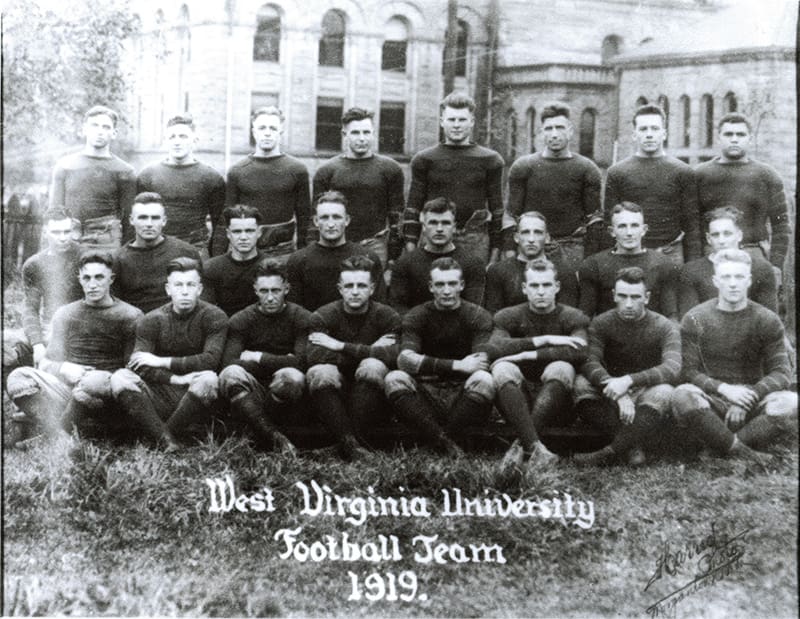
The West Virginia team pictured on its Morgantown campus. Star "Rodg" Rodgers is 3rd from left, second row.
The Mountaineers had beaten the Princeton Tigers the previous week, and beaten them badly, 25-0.
West Virginia was 5-1 going into the Centre game.
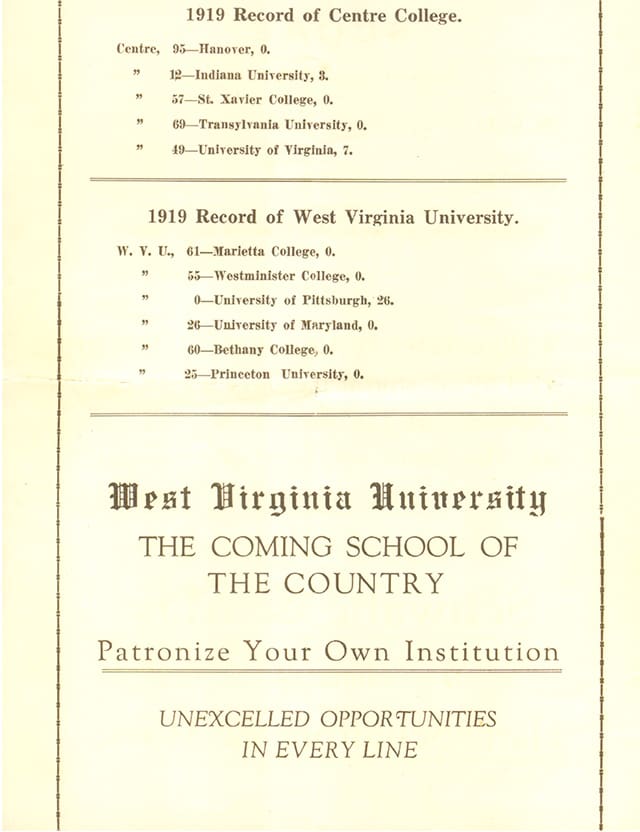
From the West Virginia-Centre program
In the loss to Pittsburgh, the Mountaineers had literally beaten themselves as they fumbled 3 times early in the game and fell so far behind, 19-0 in the first quarter, that they found themselves playing catch-up, getting out of their normal game plan and rhythm.
However, the dominant victory over Princeton, played at the Tigers’ Palmer Stadium, caught everyone’s attention, big-time. You just didn’t go onto the home field of one of the “Big 3” and dominate, but that is just what West Virginia did.
The Mountaineers’ star was Ira Errett “Rodg” Rodgers who stood 5”10” and weighed a solid 198. He was an all-around threat, very fast and adapt at either sweeping around the ends or executing pinpoint passes, even though he played at the fullback position.
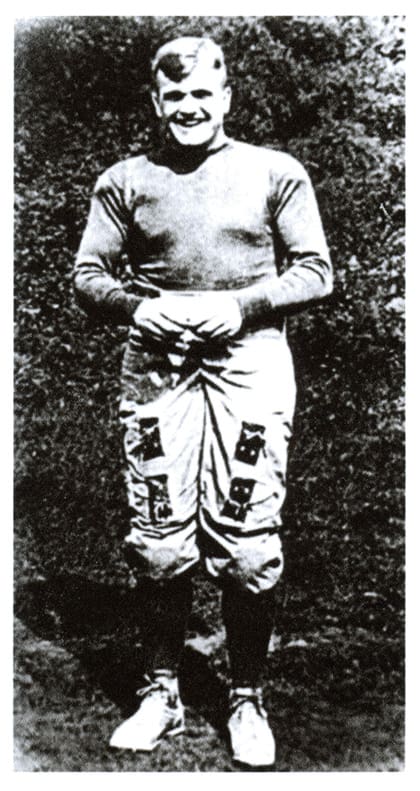
Ira Errett "Rodg" Rodgers, star fullback
George Underwood, writing in the New York Herald, stated, “There was no stopping of Rodgers who gave as thrilling an exhibition of offensive play as has ever warmed the heart of a football fan. He battered his way through the Princeton line, and skirted the ends for comfortable gains repeatedly. It was his accurately hurled forward passes, however, that tied the most knots in the Tigers’ tails.
Princeton’s coach, Bill Roper, penned a newspaper column after his team’s game with West Virginia in which he explained how he felt that Rodgers and his teammates had revolutionized the passing game.
He wrote that West Virginia used deception so effectively, with their opponents concentrating on three men on the wings while another player delayed and then went unnoticed across the line of scrimmage and received a pinpoint pass.
He said that Rodgers was particularly effective in throwing a forward pass, looking over the backfield and then often passing the opposite way from where he was looking.
He has a clever way of backing off from the ends coming through to hurry the pass. I do not think that you can stop the West Virginia passing game without having seen it before.

Little did anyone realize that Centre, a little unknown Kentucky college, had indeed seen West Virginia’s passing game before.
When the October 11 game was cancelled by Maryville because of having so many players banged up during its game with Tennessee, Centre realized that the open date offered an opportunity.
It was decided that Centre should scout West Virginia during its October 11 game at Pittsburgh and knew that no one could effectively analyze an opponent better than Bo McMillin. Bo was perfect. No one would recognize him. He’d just be another student in the stands. The notes that he took on the train ride back from Pittsburgh played a big role in the game plan that Centre planned for the November 8, pivotal game with the West Virginia Mountaineers.
All week before the game, Uncle Charlie had the scrubs out on the practice field running through the plays that Bo had brought back from Pittsburgh and devising strategies against both the offensive and defensive formations that West Virginia had utilized.

Scrimmaging against reserves prior to the West Virginia game. The wooden stands are noticeable which stood before the new stadium was built in 1923. The field was in an east-west configuration behind the Boyle-Humphrey Gym, Old Main, and Young Hall. Red Weaver is streaking down the field in the left side of the photo. Bo McMillin can be seen running the ball in the background with Red Roberts wearing white headband leading interference. Army Armstrong is blocking ahead of Red.
It was almost like in the modern age when teams have films from their opponents’ previous games. Centre was prepared. Now all that remained was to execute.
The game with West Virginia was scheduled for 2:30 at Laidley Field in Charleston, WVA which was the first game ever played in the newly constructed stadium. Laidley Field was built with wooden bleachers in 1919 and had a capacity of 5,000.

This grainy photo is the only one that could be located showing Laidley Field as it was originally built in 1919.

The exact section shown in the upper photo is shown below after it collapsed in 1923. If you look at the homes in the background, the site is identical.
( On November 10, 1923, when West Virginia was playing Washington and Lee, a portion of the stadium holding over 500 people collapsed. Fortunately, even though there were broken limbs, there were no fatalities. The facility was demolished and a new concrete stadium with a capacity of 14,000 was build and ready for the 1924 season. It is now the home field of the University of Charleston and has been expanded to hold 18,500. )
Dr. Ganfield had cancelled classes for Saturday. Centre had 193 students enrolled in 1919. When the team members and students attending the game were added, approximately half of the student body was on the way to Charleston, plus a considerable number of other Kentuckians were on the train.
Even though Kentucky was fairly represented, the capacity crowd of 6,000, including those standing, would be clearly be cheering for the Blue and Gold Mountaineers.
The train ride down from Morgantown was only 150 miles, plus Charleston had a large alumni group who would be at the game, and other local fans would obviously be for the boys from their own state.
It was a perfect fall day for a football game as the teams lined up for the opening kick.
A mummer went through the Kentuckians in the stands. Red Weaver was lining up without a helmet.

Red Weaver
Red Roberts never wore a helmet. He just wrapped a white, silk scarf around his head, protecting his ears. Everyone else normally wore a helmet. Weaver had failed to pack his and decided that he was going to just play bareheaded.
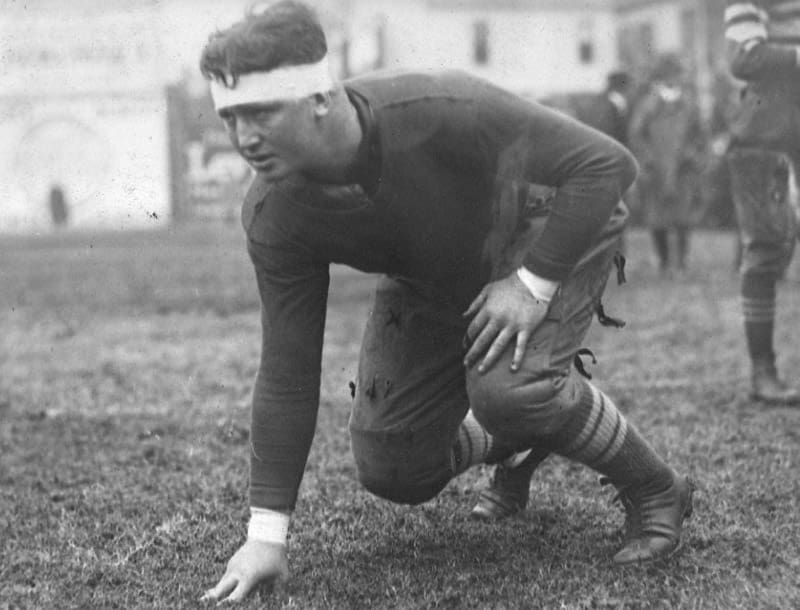
Red Roberts and his white, silk scarf
Early on, it looked like Centre had more than met its match. After running back the kickoff, Rodgers completed several passes, and then in one of the rare times that he was able to get outside of Centre’s ends, he got to the 1 and bucked it in on the next play.
Rodgers missed the extra point and it was West Virginia, 6-0.
Centre wasn’t daunted and came back strong and marched right down the field and scored but it was called back due to a holding penalty.
On the next play, Bo faded back and hit Red Roberts with a perfect, 20-yard pass for another TD, but it was called back because Bo hadn’t been 5 yards behind the line of scrimmage when he threw the ball, which was a rule at the time.
The game began to resemble the Indiana game. Centre could move the ball everywhere except over the goal. And again, just like at Indiana, Centre’s defense was impregnable.
It was 6-0 as the first quarter ended.
The second quarter was just as the first period had played out after the West Virginia score. Centre dominated, picking up 10 first downs to the Mountaineers’ 2, but couldn’t get the ball across the goal, and it remained 6-0 at the half. The Centre backfield had run almost at will.

Backfield against West Virginia. Left to right-Bo McMillin, Allen Davis, Red Roberts, Norris "Army" Armstrong
Centre had never let Rodgers or any Mountaineer get outside its ends after that first drive. Matty Bell and Terry Snowday had followed Bo’s advice and totally bottled-up West Virginia’s attempts at end sweeps. The tackles, Sully Montgomery and Howard Van Antwerp, and guards, Ben Cregor and Bill James, had dominated in the trenches.
Red Roberts was playing linebacker on defense. If any Mountaineer managed to penetrate Centre’s line, whatever progress they had made was quickly cut short by a crunching tackle by the big redhead. Red Weaver, even without a helmet, played his usual ferocious game at the other linebacker position.
At the half, the Colonels congregated in the end zone and Coach Moran and Chief Myers were pleased with what they had seen on the field during the first 30 minutes.

In the end zone at the West Virginia game, left to right- Bill James,
Ben Cregor, Army Armstrong, Joe "Chick" Murphy, Coach Uncle Charlie Moran
There was just one concern.
Red Weaver didn’t seem to know what was going on. He was confused and not making sense. Moran told him to sit down and rest. He realized that Red had taken some hard knocks and it was apparent that not having a helmet hadn’t helped the situation.

Red Weaver
The coach recognized a fan up in the stadium who he knew always carried a flask and motioned for him to come down to the end zone. He told the fan that Red needed a “stimulant.” He didn’t want to lose one of his stars during this extremely important game.
The players were gathered in a circle around Weaver as Moran took the flask and told his center to start to drink because it would "clear his head." Weaver did just that, and as the halftime break ended, he was up and raring to go.
West Virginia kicked off to start the second half, and Centre completely took over the game, beginning on its own 20.
Bo streaked around his left end for 12. Red Roberts plowed right through the line for 10. It was first down on the 42.
Bo fired a pass to Army Armstrong for another first down. The ball was now in the Mountaineers’ territory.
Bo wiggled for 8. Red got another 3. It was another first down. Murphy, who was Centre’s only substitute during the game, ran for 7. Bo then hit Terry Snowday, who made a spectacular leap, for a 20-yard gain.

Joe "Chick" Murphy, fleet halfback

Terry Snowday, end
It was first down on the 10.
Bo for 2. Army for 3. It was on the 5.
Bo then handed off the ball to Red Roberts who churned through the Blue and Gold defenders for a score.
It was a flawless drive, greeted by wild cheers from the Centre supporters.
A recovered Red Weaver made it 7-6.
West Virginia got a break later in the third quarter when Centre fumbled a punt and a Mountaineer recovered the ball on the Colonels’ 20. Rodgers completed a 10-yard pass and had his team just inside the 10-yard marker, first and goal.
Centre dug in.
West Virginia tried 3 straight line bucks.
3 yards. 2 yards. No gain.
On 4th down, on the 5, Rodgers took the center pass and fired into the line.
The right side of the Colonels’ line, led by Ben Cregor and Bill James, hit the big fullback and held him to a yard.
The quarter ended shortly after and the teams switched positions on the field with the Colonels on their own 4. Being so deep in its own territory, it may have been prudent to have Red Roberts boom out one of his towering punts. He averaged 48 yards during the game.

Cartoon published after the West Virginia game featuring Red Roberts
Bo and his teammates had other plans.
On 4 successive plays, first Bo, then Army, then Red, and finally Murphy, gained at least 10 yards on the ground. Uncle Charlie’s players were sweeping the Mountaineers out of the way, simply overwhelming them.
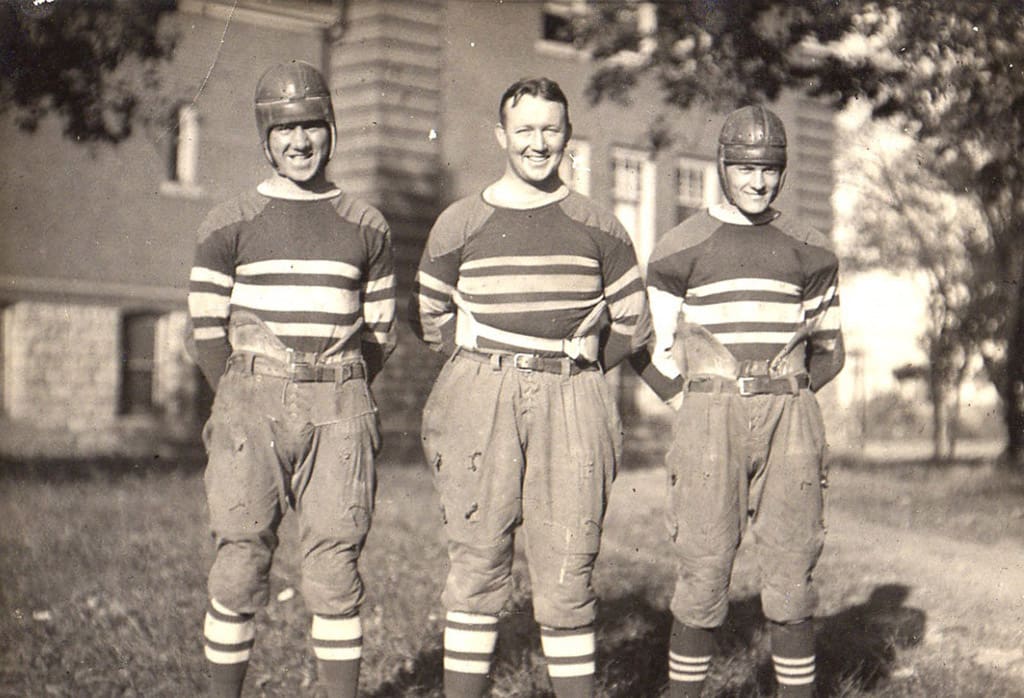
Bo McMillin, Red Roberts, Army Armstrong
The ball was at midfield when Terry Snowday, switched into the backfield, cut back from his position on a reverse sweep around the left side and racked up 25 yards. The Colonels' backs had run their fakes so effectively to the right that the Mountaineers had been totally confused, thinking the play was heading that way while Snowday streaked in the opposite direction.
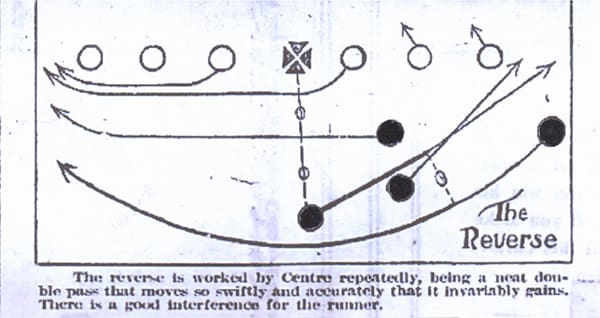
The reverse as drawn up by Uncle Charlie. This image came from Moran's actual drawing and resulted in a 25-yard gain by Terry Snowday.
The ball was at the 25 when Red bulled for 5. Murphy took it down to the 10 and then Bo took the center pass from Weaver and side-stepped his way over the goal.
Weaver was perfect on the PAT and it was 14-6.
The extra point missed by Rodgers early in the game now had increased importance. Even if West Virginia put 7 points on the scoreboard, it would still be 14-13, Centre. It didn’t look likely that the Colonels would give up any points so late in the game, much less a TD and possible field goal, the way that they were dominating the boys from Morgantown.
Rodgers fielded the kickoff after Centre’s score and returned it 35 yards, the longest gain all afternoon for West Virginia. The desperate Mountaineers began a drive with frequent running plays but were using up a lot of clock.
George Joplin, reporting for the Lexington Herald, wrote that, The West Virginians were fighting like wild men, and the crowd of 6,000 was begging for a touchdown, while the Centre partisans were shouting encouragement to their team.
The Mountaineers drove to the 5, but they were stopped cold by 4 viscous tackles by the Colonels. It was like there had been an impenetrable wall of steel constructed.
Red Roberts kicked out of danger and West Virginia again went on the attack but fumbled on its second play, and Roberts scooped up the ball and ran for 25 before being dragged down.
Centre was content to run out the clock.
Murphy gained 10. Bo got 8, and time expired with the Colonels on the 12, threatening to score again.
The Colonels had been totally dominating in the second half with 14 first downs to the Mountaineers' 5.
The Kentuckians in the stadium raced onto the field and embraced their weary warriors, slapping them on the back, hugging them and pumping their fists in the air. Unlike the win over Virginia, when the celebration began only after the return to Danville, it began on the train as the team and fans made the journey back through West Virginia, across the state line into Kentucky, and had hardly died down as the last leg of the trip carried the happy throng to Lexington and then back to the Southern station in Danville.
Word of the victory had been telegraphed ahead. Both of the Danville newspapers, the Advocate and Messenger, had printed bold headlines and pasted them on sandwich boards which were worn all over town by their paperboys, announcing-
Centre 14 W.Va. 6 !
Team Arrives 11:30 P.M.
Meet the Boys at the Station
And meet them they did.
It seemed the entire city of Danville and all of the students who hadn’t attended the game turned out.
Again, the huge crowd cheered and snake-danced up from the station, led by the Gold and White’s banner carried on the eagle-tipped flagpole, though the campus, on to Main Street, finally ending up front on the lawn of the buildings at K.C.W.
It was well past midnight before the delirious fans reached exhaustion and began to filter back to their homes, and the lights began to dim all over the small town of Danville.
Little Centre College had beaten the mighty West Virginia Mountaineers.
Little Centre College had beaten the conquerors of Princeton.
Little Centre College had changed the face of college football.

Coverage of the game

More coverage

Centre for the first time being compared to Harvard and Princeton, 2 members of the "Big 3" and now "is on the football map."
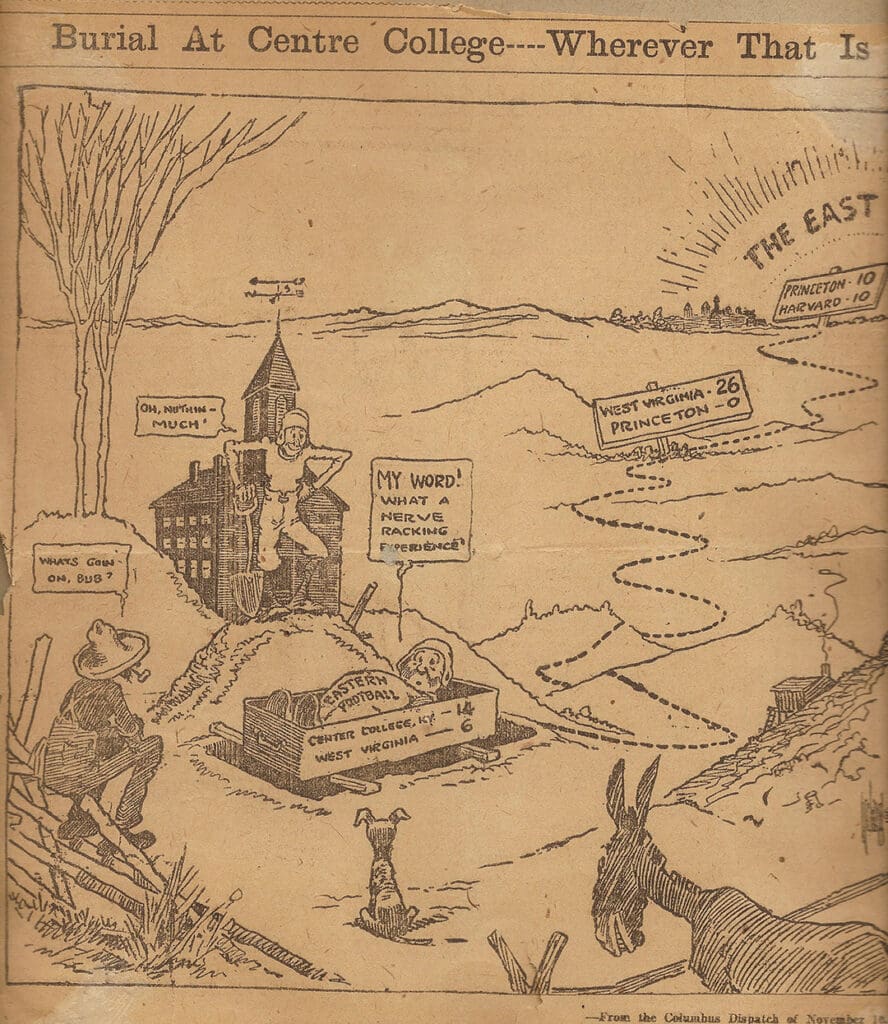
Cartoon published in the Columbus ( Ohio ) "Dispatch" after the win over West Virginia. It was recognition Centre sought, "Wherever That Is," and was now getting all over the country.
